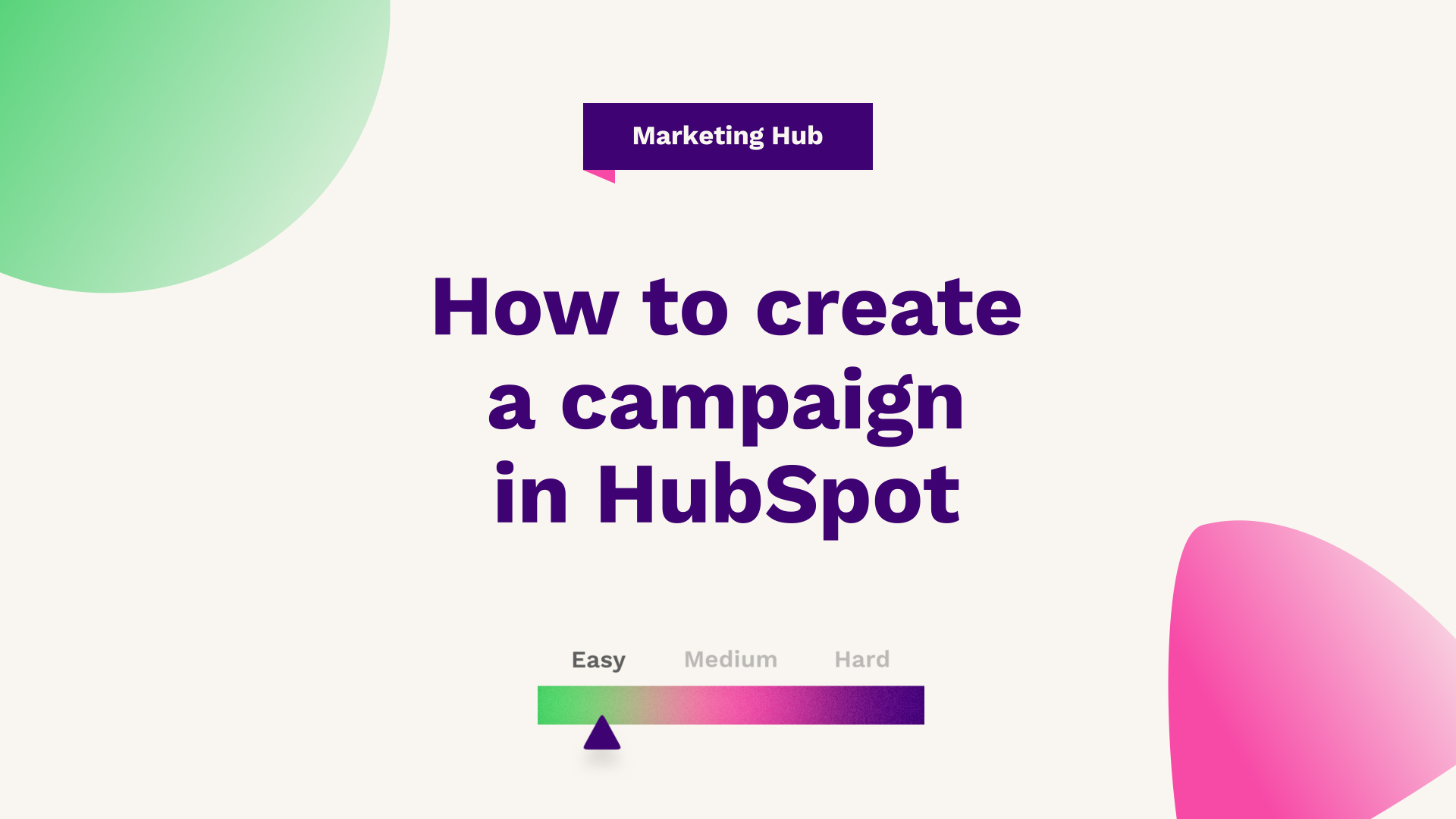
Sam Banks, our Technical Digital Strategist at Fuelius, explains how to create a campaign in HubSpot, watch the video or follow the guide below…
Hub: Marketing
Difficulty: Easy
Tier: Pro/Enterprise
We're going to be talking about campaigns, and more specifically, we're going to be talking about attribution and how we can actually report on our campaigns and ultimately their contributions towards sales and ultimately revenue. So, if you are a HubSpot user already, you'll be somewhat familiar with campaigns.

How to create a campaign?
The Campaigns tool in HubSpot allows you to track and manage your marketing campaigns in one place. With the ability to see goals, audience and budget, you can control specific elements and assets of your individual campaigns. Find out how to set up a campaign in HubSpot, plus how to use them to report on the marketing attribution and ROI of campaigns.
Now, the common pain point that we often find is people build robust dashboards. These are really good to show us overall pictures of data, but this picture of data doesn't necessarily correspond to a particular tactic or action. That's where HubSpot campaigns come in. So in order to access HubSpot's campaigns, you just simply need to go to marketing and then campaigns.
From here, you can actually create a new campaign or filter existing ones based on aspects such as when they were created. Goals, audience, dates, and budgets can all be set, ensuring you have more control over specific actions with certain resources or investments put into internal marketing.
Attribution
From here, poor metrics can be viewed such as how many sessions this campaign brought in, and how many new contacts that we did not know prior to this campaign in the hub. Compared to how many contacts we already know. With any of these metrics, you can actually click into the actual metrics to display a bigger breakdown of who the contacts are and what the deals are as well. Along the top, you can actually switch the attribution between first and last. Which will dynamically change the figures depending on the source or the kind of type of campaign that you're looking to run.
If it's a campaign that's focused on lead generation, you may want to attribute it to the first touch. However, it's a re-engagement campaign. It may want to focus more on the last touch, and with anything in HubSpot, you can filter it by date range as well. If you scroll down, you'll be able to see general kinds of rules of film in terms of big pictures, in terms of when the sessions took place and how many contacts, either new or influenced, which you can click and filter between.
Reporting on campaigns
But, more specifically, you can actually break this down to the individual channels or tactics that you may have taken. So in terms of the actual micro-actions you did with that campaign, how did it, how many emails did we actually send? How many landing pages did we set up, and how many views and submissions?
How many social posts did we actually send and how many clicks on each retrospective network? And then what automation strings did we also set up from here? What it allows you to do is actually see all the assets that you create across HubSpot's wide array of tools in one central place. Meaning you can look at any time over all the emails that were associated with the campaign and the landing pages that you set up and all the different social pulses that you actually put out, as well as the clicks and then the overall engagement. This allows any marketing manager or sales manager to at a glancing notice how the campaign performs, along with the key performers versus the low performers. Allowing us to do tactical, even soft changes if we were to run the campaign again, or more specifically, look at maximising the top performers in terms of what emails and so on and so forth.
The great thing about the campaign's tool is you can actually utilise it as a central hub, meaning, you can click on various CTAs, and it will actually take you to the respective kind of email and show you what those look like. Lastly, what you can actually do is have separate tabs, meaning you can see dashboards that have been created based on the revenue that is attributed to certain categories. So, of the contacts that were created how many came through the landing page versus integrations versus imports, and the kind of assets versus contacts being created by different asset titles?
You will actually see that essentially from this campaign, all the tasks that are related to it, as well as the ones that are still open, what are due today, which are overdue, and all of which have been completed as part of that campaign, allowing to have a very soft level and management of your overall campaign execution.
Overall seamless collaboration across your actual HubSpot port is highlighted. So again, what this tool is great for is being able to actually understand at a glance, and look more in isolation at individual campaigns to assess ultimately the ROI they actually brought from a sales and a marketing perspective. You can also set up a campaign and then retrospectively add assets that you may have created prior, meaning that if you forgot to associate an ad campaign, you can actually just select the ad, find any blogs that may have actually been in there, as well as call to actions as.
You can then use the same for emails, landing pages, social polls, static lists, website pages, and workflows meaning that you can tie all your external internal automation to the campaign as well for full visibility. This will retrospectively populate all the figures that were based on the campaign as well. From here, you can actually create tracking URLs, meaning from the actual campaign, you can create a tracking URL that fits in terms of Google's guidelines for UTMs, a unique tracked parameter, and you can set the source from where it came from.
You can also set what the medium is, the term, and the content, for example for links you may distribute to partners that point back to your assets so you can easily distinguish which partners you may have worked with on this campaign that generated the most traffic, the most context, and ultimately which ones were the most effective to bring in deals.
This allows you to actually seamlessly create it all from the same interface, as well as come back to the core source reports that you've seen last, but not least, you can actually edit the campaign at any point or comment on it to actually collaborate. So you could tag in an actual team member, such as what is the status of this campaign, meaning you can actually have full visibility and all the com tasks and the overall performance on how a campaign is doing.
Last but not least, you can actually edit the campaign at any point in time. To set the actual start and the end dates, you can put a campaign colour for easy segmentation and then internal notes, such as who the audience typically was, the budget, the goal, and the notes.
So if you were to refer back in a year's time, you know exactly where you ran that campaign and what the definition of success is.
If you're looking for further HubSpot support, our team would ❤️ to help you out! Book a call with us today or head over to our video hub for more HubSpot tips.




